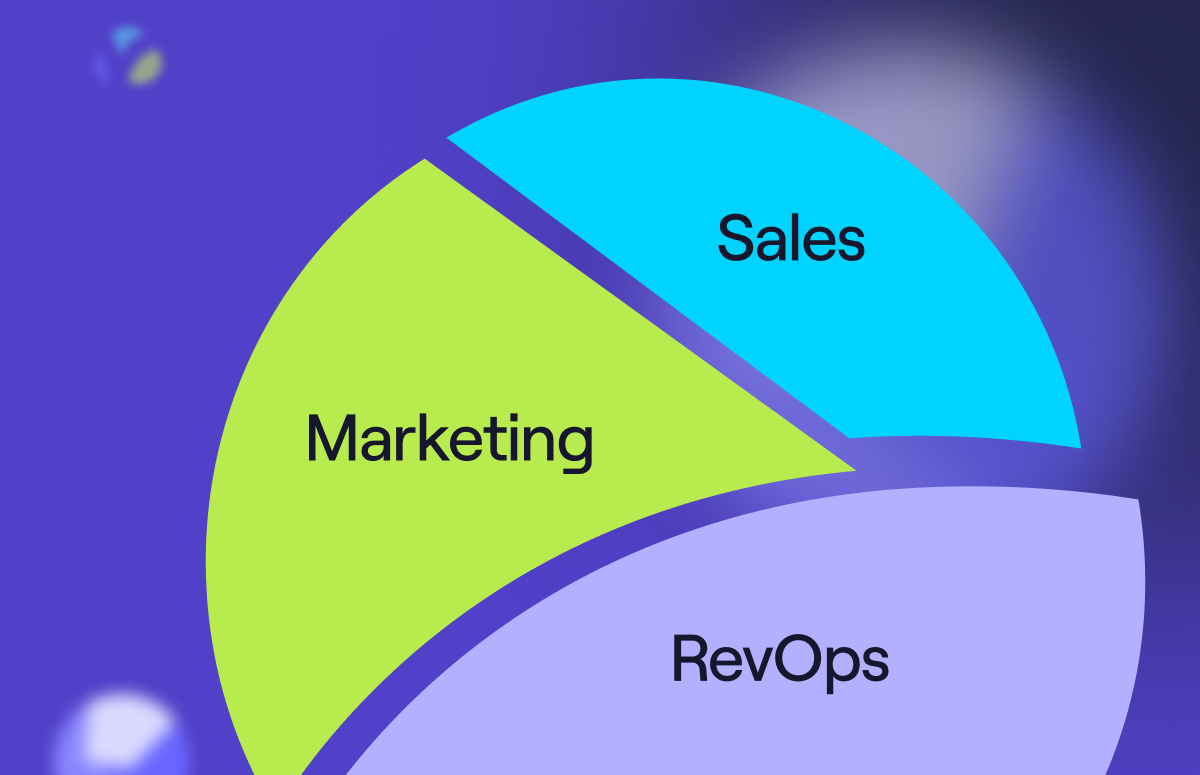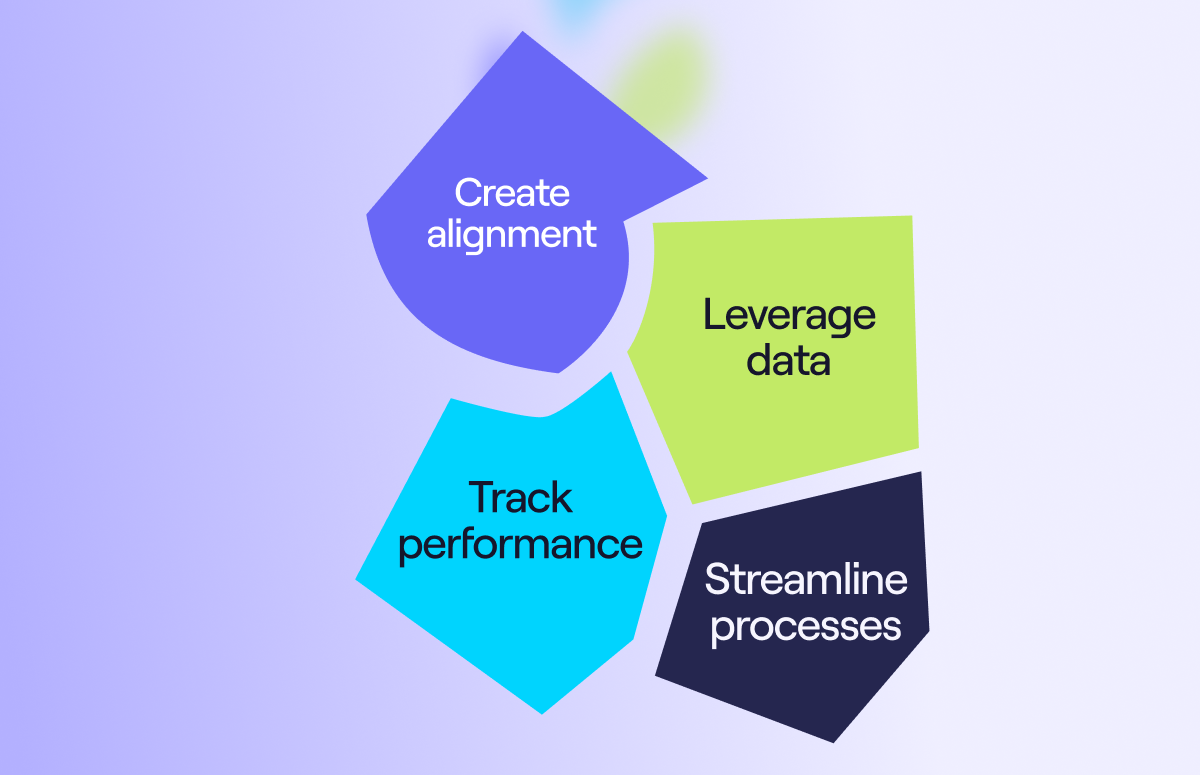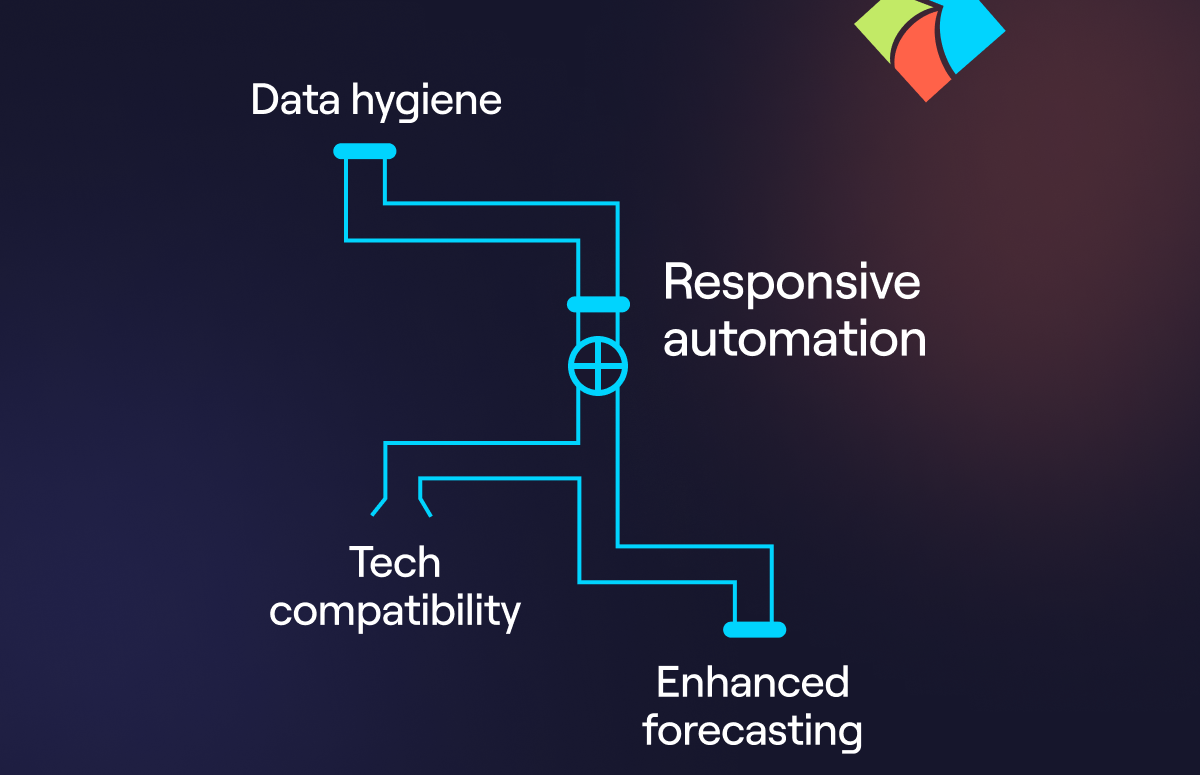How to Build the Perfect RevOps Tech Stack
RevOps tech stack menu:
What is the backbone of a strong revenue operations team?
For many RevOps leaders, it’s their tech stack. A good RevOps tech stack enables efficient processes and workflows, enhances decision-making, and helps to unite teams and deconstruct siloes at a technical level.
The thing is, there are many tools out there vying for a share of your software spending! The question is, which to choose?
In this guide, we’ll explore how to build the ideal revenue tech stack. We’ll discuss:
- The main types of tools you’ll need.
- What you’ll need to bear in mind when building your stack.
- Typical implementation challenges and how to overcome them.
Let’s go! 👇
What is a RevOps tech stack, and why is it important?
A RevOps (Revenue Operations) tech stack is the collection of software tools and technologies that enable the revenue teams - sales, marketing and customer success - to work together more effectively.
A good revenue operations tech stack facilitates seamless collaboration within and between teams. It allows for data-driven decision-making, streamlines workflows with automation, and ensures the entire revenue organisation shares a single source of truth.
For B2B businesses looking to break down silos between departments, the RevOps tech stack plays a crucial role. Integrations and automation facilitate seamless data sharing and more efficient processes that serve these common goals:
- Enhancing the customer experience.
- Boosting team productivity.
- Supporting consistent revenue growth.
Of course, your tech stack’s ability to achieve those goals depends on the individual platforms within it.
What types of tools do you need in your RevOps tech stack?
The RevOps tech stack often consists of diverse tools interconnected with native integrations and custom workflow automation.
These are the eight most common categories of software tools you’ll find in a RevOps tech stack:
1. CRM
The CRM (customer relationship management) platform is the central hub where all customer data is stored.
It stores essential B2B data on existing customers and prospects in the sales pipeline.
2. Sales enablement
Sales enablement platforms provide tools for improving sales performance, such as:
- Sales content management.
- Training and onboarding.
- Automated sales sequences and email campaigns.
- Battlecards and objection-handling advice.
3. High-quality data enrichment
The best RevOps strategies are built on a solid foundation of high-quality data.
RevOps data solutions like Cognism provide sales and marketing teams with timely, accurate data. They help leaders calculate their TAM (total addressable market), plan territories, and reduce wasted time with its AI-powered Sales Companion.
4. Revenue intelligence
Revenue intelligence platforms use advanced AI to analyse current workflows and provide actionable advice. These tools can:
- Highlight at-risk deals.
- Analyse call recordings and provide coaching insights to sales reps.
- Improve forecast accuracy, helping sales team leaders make more informed decisions.
5. Billing
A good billing tool can help streamline subscriptions for your RevOps tools.
They can automate billing and credit card charges, offer multiple payment options to improve the customer experience, and support discounts, trials, and upsells.
6. Marketing automation
Marketing automation tools go beyond simply automating Google Ads and email marketing.
They can help you:
- Improve your lead scoring and routing systems.
- Use behavioural tracking to monitor how prospects interact with marketing assets.
- Enable targeted, high-touch campaigns for specific accounts.
7. Customer success and support
RevOps isn’t just about creating new revenue. It also intensely focuses on reducing churn and keeping existing revenue.
Customer success tools help achieve this goal by identifying churn signals, generating customer health scores, and streamlining support ticket handling.
8. Analytics, reporting, and forecasting
Finally, we have the category of reporting and forecasting tools.
While many tools we’ve discussed - such as sales enablement and B2B marketing solutions - include some reporting features, many RevOps leaders want to unite all data visualisation capabilities in a single dashboard.
That’s where a RevOps reporting tool comes in handy. It allows you to integrate your data sources into a single platform so you can go in on Monday, load up your dashboard, and see how things are tracking without having to switch between 12 different tabs.
How do you choose the right tools for your RevOps tech stack?
When building an effective revenue operations tech stack, you must balance current needs, future growth plans, budgetary considerations, and compatibility.
Here, we examine some of the most important factors to consider when assembling your ideal tech stack.
Prioritise your goals
What are the biggest business goals you want to accomplish with your RevOps tech stack?
For instance, your priority might be improving pipeline visibility, reducing manual tasks with RevOps automation, or tearing down team silos.
Of course, all of the above might be goals, but determining your priorities tells you where to invest your resources.
Consider the trade-offs of full-suite and best-in-class products
When buying software, especially in the revenue space, there are two broad approaches to take.
You can choose an all-in-one suite that offers a wide range of tools (Salesforce is a good example) or build your stack by combining best-in-class tools, like Cognism for data enrichment and Outreach for sales engagement.
Generally speaking, all-in-one suites are cheaper overall and offer effective integrations, but they may offer limited capabilities or be concerned with revenue expansion over innovation.
Best-in-class tools offer the opposite set of pros and cons. They have deeper feature sets, offer a great degree of customisation, and tend to be more innovative companies.
Predict future needs
You need to build a stack that not only serves your current needs but will be able to handle increased complexity, more data, and larger teams as your business scales.
Look for solutions that offer a tiered approach. This way, you can start small with a basic setup and then upgrade later to access more advanced features.
Focus on effective integration
A well-integrated stack of revenue operations tools enhances efficiency and productivity while ensuring that all revenue-related teams work from a single source of truth.
So, as you’re building your stack, compatibility must be your number one concern.
Look for tools that seamlessly integrate with the platforms you already use. Some may offer APIs for building custom integrations. This will be super-important as you scale - your tech stack must grow with your business.
Calculate total cost of ownership (TCO)
When assessing SaaS solutions against one another, it’s easy to fall into the trap of just looking at the headline monthly investment.
But this isn’t the entire cost of a given purchase.
The total cost of ownership (TCO) includes not online licensing fees but implementation and onboarding costs, maintenance, training, and potential downtime.
Take all of these factors into account as you seek to build a stack that fits your budget.
Plan for adoption and enablement
A good tech stack is only effective if your team knows how to get the most out of it.
Thus, working on structured onboarding and training to ensure team adoption is an important part of building your stack.
You’ll also want to choose tools that are intuitive and user-friendly (this improves adoption rates) and align with your company’s culture.
For example:
If your team prefers mobile-first solutions, ensure the tools have strong mobile functionality.
Leverage automation and personalisation
One of the core principles of RevOps is process optimisation. Automation is a key driver here.
Invest in marketing and sales tools that automate repetitive tasks and free teams up to focus on strategy.
For example:
AI-driven customer service solutions like Drift or Intercom can handle simple customer interactions, giving your support reps more time to focus on the difficult, hairy cases.
Embrace AI and machine learning
AI is increasingly central to modern RevOps stacks. Look for tools that are AI-first and/or show strong signs of innovation.
Here are some use cases of AI for RevOps teams:
- Predictive analytics to identify trends and recommend actions to optimise deal cycles.
- Improved search functionality in sales databases (like Cognism’s AI Search and Sales Companion).
- Machine learning models that can identify churn risks and improve audience segmentation.
What are the common challenges when building a RevOps tech stack (and how do you overcome them)?
Building a strong RevOps tech stack isn’t always easy. Many leaders face challenges as they do so.
Here are some of the most common hurdles that arise when setting up a RevOps stack, plus some tips on overcoming them.
1. Siloed tools and data
Most RevOps leaders aren’t building a tech stack from scratch; there’s usually an existing set of tools used by sales, marketing, and customer success teams.
Unfortunately, they’re often disparate and disconnected tools, leading to data quality issues, silos and inefficiencies.
Solving this is step one. Some strategies include:
- Building custom integrations to connect existing tools.
- Using a data warehouse like Snowflake to unify data across platforms.
- Expanding your use of an existing suite to cover more ground and have the whole revenue organisation working in a single workspace.
2. Overlapping or redundant tools
Redundancy is another issue that pops up as your tech stack grows.
Many tools have similar functionalities, which end up wasting budget and complicating workflows.
The solution here is to regularly audit your stack to look for overlap. Tools like Vendr can help you automate this process.
3. Poor adoption by teams
Even the best tools are useless if your team doesn’t use them effectively. This most commonly happens due to two reasons:
- A lack of proper training and onboarding.
- Overly complex and non-user-friendly interfaces.
The solutions here are self-explanatory: prioritising modern, user-friendly tools and developing hands-on training and onboarding sequences alongside ongoing support and helpful internal documentation.
4. Inadequate data hygiene
Dirty data (which includes duplicate, outdated, inconsistent, and just plain incorrect data) can easily undermine even the most advanced tech stack and efficient workflows.
You’ll want to establish some good data hygiene practices, including providing guidelines for entering data, scheduling audits for data integrations, and setting up a regular data enrichment protocol.
5. Scalability issues
Tools built for teams of 10 aren’t usually a good fit for teams of 1,000.
When building your tech stack, you’ll need to think long-term. Look for solutions that can scale up and meet future business requirements.
Where this isn’t possible, consider what the “end of life” point looks like for a given software solution.
6. Budget constraints
Balancing cost efficiency and desired functionality can be tricky. This is especially true for growing companies with limited budgets.
Here are a few solutions for overcoming budget constraints:
- Focus on your core goals and invest in tools that help you meet them. Disregard “nice-to-haves” until you’ve achieved a better measure of business success.
- Start with all-in-one solutions that give you a wide variety of tools. As your business and budget grow, upgrade to best-in-class solutions and design a custom tech stack.
- Look to negotiate pricing where possible. Consider phased implementations to spread out costs.
7. Vendor lock-in
Relying too heavily on one vendor’s ecosystem of tools can make it difficult to adapt or switch tools as your needs evolve.
This is a challenge for small businesses that start out with all-in-one suites for cost-efficiency reasons and then find themselves trapped in a closed ecosystem.
If possible, build your current tech stack from a range of best-in-class tools. If this isn’t an option due to budgetary or technical constraints, look for open systems and tools with strong integrations that will allow you to add to your stack later as your company’s needs become more specific.
How do you measure the ROI of a RevOps tech stack?
High-performing tech stacks generally don’t come cheap!
So, it makes sense that RevOps leaders want to accurately measure the ROI on their spend.
Here are a few tips on doing just that:
- Define your KPIs, such as revenue growth, customer acquisition cost (CAC), customer lifetime value (CLV), or sales cycle length.
- Monitor changes across these core metrics after implementing a new piece of software.
- Track efficiency gains by looking at improvements in lead handling time, manual task reduction, and onboarding efficiency.
- Measure data accuracy by assessing forecast accuracy, data completeness, and pipeline visibility.
- Assess cross-team alignment by examining lead handoff speed and quality, churn rates, and campaign effectiveness.
- Analyse specific use cases of where your tech stack has directly impacted results, such as successful campaigns, faster deal closures, or reduced churn, to illustrate tangible value.
Data that powers your revenue strategy
Even the best RevOps tech stacks are ineffective if they rely on poor-quality data.
That’s why the most effective RevOps teams put a strong focus on improving data quality.
And here at Cognism, we’re ready to help you do just that!
We have the best B2B data in the game, with phone-verified numbers and the strongest European coverage around.
Book a demo with our team, and we’ll show you how our data solutions can benefit your business today.


